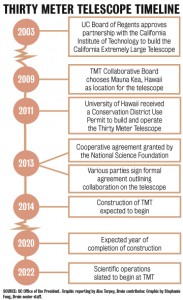The original version of this article contained multiple errors and has been changed. See the bottom of the article for additional information.
The University of California has committed millions of dollars and administrative manpower in recent years to build its biggest technology project yet – a 30-meter-diameter telescope that will capture and detect light to a capacity that has never been possible before.
The UC Board of Regents approved the University’s involvement in the construction and operation of the telescope last month, despite some concerns from an environmental group located in Hawaii, where the new telescope will be built.
The Thirty Meter Telescope Corporation is an international partnership between the UC, the California Institute of Technology and astronomical institutions and governmental agencies from Canada, China, India and Japan.
The telescope will be located on Mauna Kea in Hawaii, where the UC’s current two largest telescopes, Keck 1 and Keck 2, are located at the W. M. Keck Observatory. The Keck telescopes are each 10 meters in diameter. By the time the facility is comepleted in 2022, it will have cost about $1.5 billion to build.
The UC Office of the President has said it will cut funding from its first observatory, the James Lick Observatory, in 2018 so it can focus its funds on newer telescopes like the ones at its W. M. Keck Observatory and the Thirty Meter Telescope, a decision that has sparked opposition among the observatory’s supporters and employees.
“The Thirty Meter is a huge bargain for UC,” said Sandra Faber, interim director of UC Observatories, the body that manages the University’s involvement in current telescope projects.
She said the UC’s share of time may not sound significant, but in a partnership with so many contributors everyone will have to collaborate on projects and share the instruments.
However, graduate students and post-doctoral researchers will not be able to apply for time at the Thirty Meter Telescope in their own name, as is the current policy at Keck, said R. Michael Rich, research astronomer at UCLA.
The UC Observatories Board, created to advise the UC Office of the President on how to fund University astronomy research, recommended that instrumentation for the Thirty Meter Telescope and Keck should be the top priorities for UC Observatories, said Eric Becklin, professor emeritus of astronomy and member of the board.
The UC began considering the Thirty Meter Telescope project in 2003, when the regents approved a partnership with the California Institute of Technology.
The regents voted to help create this new telescope to keep up with competition in astronomy research and technology. The European Southern Observatory in Chile plans to build a 39-meter telescope, and the Carnegie Institution for Science in Washington D.C. is planning a telescope with a 22-meter mirror, Faber said.
What is novel about the Thirty Meter Telescope is its size, not the technology of its mirror, said Garth Illingworth, UC Observatories astronomer and co-chair of the Science Advisory Committee to the Thirty Meter Telescope. It will contain 492 hexagonal segments of aluminized glass.
The area of the new mirror in the Thirty Meter Telescope will be nine times larger than Keck’s, said Geoffrey Marcy, professor of astronomy at UC Berkeley and member of the UC Observatories Board.
“The area of the mirror is what collects the photons coming from the distant galaxies and stars, and every photon is precious,” Marcy said.
The new telescope will be able to collect faint light from some of the earliest galaxies in the universe that no other telescope on Earth could capture, he said. With this previously undetectable light, astronomers will be able to study some of the first stars that formed after the Big Bang.
However, the projected environmental impact of the new observatory on Mauna Kea is a source of controversy among some native Hawaiians.
Kahea, a Hawaiian environmental advocacy group, has a three-year history fighting the construction of the new telescope. The group argues that Hawaiians consider Mauna Kea to be a sacred temple.
“It is one of the most important cultural areas in Hawaii,” said Candace Fujikane, member of Kahea and associate professor at University of Hawai’i at Manoa.
According to a 2010 environmental impact statement by the University of Hawai’i at Hilo, the Thirty Meter Telescope Observatory will have “minimal impact on existing facilities.” The report also said that the observatory will “add a limited increment” to the already existing impacts on the environment in the region.
Hawaii’s Board of Land and Natural Resources issued a permit earlier this month for the Thirty Meter Telescope Observatory to operate on protected land. The Thirty Meter Telescope Corporation will sublease land from the University of Hawaii for the project.
“For many years, we have been … ensuring that (our organization) listens and is sensitive and responsive to ideas that our neighbors and friends may have about our project,” said Henry Yang, chair of the TMT Collaborative Board of Directors in a statement.
The Thirty Meter Telescope will be the first of the next generation of astrophysics technology. Construction on the telescope could begin as early as this summer, Yang said.
Correction: The University of California will pay 12.3 percent of the $39 million annual operating cost of the planned 30-meter-diameter telescope in Hawaii. The California Institute of Technology is one of a number of universities and governmental organizations that makes up the Thirty Meter Telescope Corporation.

Great article, but it needs a quick correction. “California Institute for Technology” should read as “California Institute of Technology.” The former name does not exist. Thank you.